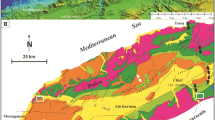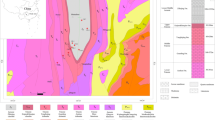Abstract
Elemental mobility based on major element geochemistry from 58 horizons related to six paleosols profiles in a typical Miocene — Pliocene Siwalik fluvial sequence in the NW Himalaya has been reported here. The paleosols developed over felsic parent material of fine to medium grained sandstone indicate notable enrichment of sesquioxides (Al2O3 = 29 % and Fe2O3 = 54 %) depicting significant leaching and dissolution. The depletion of base cations (mean wt% of Na2O = 0.24; CaO = 0.51) and SiO2 (mean wt% = 63.6) in the pedogenic layers and its enrichment in the parental material (mean wt% of Na2O = 0.44; CaO = 1.3; SiO2 = 70.1) shows a good gradient of elemental mobility due to pedogenesis. Bivariate plots of the base ratios (Na2O/K2O, CaO/K2O, and MgO/K2O) vs. Al2O3 reveal independent distribution for parent material, pedogenic horizons and the incipient zone indicating the gradual addition/removal of immobile/mobile elements with varying pedogenesis. Discontinuous and segmented pattern of the geochemical parameters enables discrimination of multiple pedogenic episodes and recognition of soil welding processes in the multistorey composite paleosols. We also test the applicability of the geochemical climofunctions: the Mean Annual Precipitation (MAP) and Mean Annual Temperature (MAT); that demands more data for calibration in the Siwalik paleosols.
Similar content being viewed by others
References
Bagati, T.N. and Kumar, R. (1994) Clay mineralogy of the Middle Siwalik sequence in Mohand area, Dehradun: Implications for climate and source area. In: R. Kumar, S.K. Ghosh and N.R. Phadtare (Eds.), Siwalik Foreland Basin of Himalaya. Himalayan Geol., v.15, pp.219–228.
Birkeland, P.W. (1974) Pedology, weathering and geomorphological research. Oxford University Press, USA, 285p.
Birkeland, P.W. (1999) Soils and Geomorphology. Oxford University Press, New York, 430p.
Dubbin, W. (2001) Soils: past and present. Geology Today, v.17, pp.225–228.
Fitzpatrick, E.A. (1986) Soils, their formation, classification and distribution. ELBS, Longman, Hong Kong, 353p.
Gross, G.M. (1971) Carbon determination. In: R.E. Carver (Ed.), Procedures in sedimentary petrology Wiley-Interscience, New York, pp.573–596.
Jenny, H. (1941) Factors of soil formation. McGraw-Hill, New York, 281p.
Jenny, H. (1980) The soil resource. Springer-Verlag, New York, 377p.
Kraus, M.J. (1992) Mesozoic and Tertiary paleosols. In: I.P. Martini and W. Chesworth (Eds.), Developments in earth surface processes 2. Elsevier, Amsterdam, pp.525–542.
Kraus, M.J. (1999) Paleosols in clastic sedimentary rocks: their geologic applications. Earth Sci. Rev., v.47, pp.41–70.
Kumar, R. (1993) Coalescence megafan: Multistorey sandstone complex of the late-orogenic (Mio-Pliocene) sub-Himalayan belt, Dehra Dun, India. Sedimentary Geol., v.85, pp.327–337.
Kumar, R. and Nanda, A.C. (1989) Sedimentology of the Middle Siwalik Subgroup of Mohand area, Dehradun valley, India. Jour. Geol. Soc. India, v.34, pp.597–616.
Kumar, R., Sangode, S.J. and Ghosh, S.K. (2004) A multistorey sandstone complex in the Himalayan Foreland Basin, NW Himalaya, India. Jour. Asian Earth Sciences, v.23, pp.407–426.
Kumaravel, V., Sangode, S.J., Siva Siddaiah, N. and Kumar, R. (2005) Rock magnetic characterization of pedogenesis under high energy depositional conditions: A case study from the Mio-Pliocene Siwalik fluvial sequence near Dehra Dun, NW Himalaya, India. Sedimentary Geology, v.177, pp.229–252.
Mclennan, S.M., Hemming, S., Mcdaniel, D.K. and Handon, (1993) Geochemical approaches to sedimentation, provenance, and tectonics. Geol. Soc. America, Spec. Paper, v.284, pp.21–40.
Munsell Color (2000) Munsell soil color charts. Gretag Macberth, New York.
Maynard, J.B. (1992) Chemistry of modern soils as a guide to interpreting Precambriam paleosols. Jour. Geol., v.100, pp.279–289.
Nesbitt. H.W., Markovics, G. and Price, R.C. (1980) Chemical processes affecting alkalies and alkaline earths during chemical weathering. Geochim. Cosmochim. Acta, v.44, pp.1659–1666.
Nesbitt, H.W. and Young, G.M. (1982) Early Proterozoic climates and plate motions inferred from major element geochemistry of lutites. Nature, v.299, pp.715–717.
Nesbitt, H.W. and Young, G.M. (1984) Prediction of some weathering trends of plutonic and volcanic rocks based on thermodynamic and kinetic consideration. Geochim. Cosmochim. Acta, v.48, pp.1523–1534.
Nesbitt, H.W. and Young, G.M. (1989) Formation and Diagenesis of weathering profiles. Jour. Geol., v.97, pp.129–147.
Nettleton, W.D., Olson, C.G. and Wysocki, D.A. (2000) Paleosol classification: problem and solutions. Catena, v.41, pp.61–92.
Ollier, C. (1969) Weathering. Oliver and Boyd, Edinburg.
Olson, C.G. and Nettleton, W.D. (1998) Paeosols and the effects of alteration. Quaternary Internat., v.51/52, pp.185–194.
Parkash, B., Sharma, R.P. and Roy, A.K. (1980) The Siwalik group (Molasse)—sediments shed by collision of continental plates. Sedimentary Geol., v.25, pp.127–159.
Quade, J., Cater, M.L.J., Ojha, P.T., Adam, J. and Harrison, M.T. (1995) Late Miocene environmental change in Nepal and the northern Indian subcontinent: stable isotopic evidence from paleosols. GSA Bulletin, v.107, pp.1381–1397.
Retallack, G.J. (1988) Field recognition of paleosols. Geol. Soc. Amer. Spec. Paper, v.216, pp.1–20.
Retallack, G.J. (1990) Soils of the past: an introduction to paleopedology. Unwin Hyman Ltd., Boston.
Retallack, G.J. (1991) Untangling the effects of burial alteration and ancient soil formation. Annu. Rev. Earth Planet. Sci., v.19, pp.183–206.
Retallack, G.J. (1995) Paleosols of Siwalik group as a 15 Ma record of south Asian palaeoclimate. Mem. Geol. Soc. India, no.32, pp.36–51.
Ruhe, R.V. (1965) Quaternary paleopedology. In: H. Wright and D. Frey (Eds.), The Quaternary of the United States. Princeton University Press, New Jersey, pp.755–764.
Sangode, S.J., Kumar, R. and Ghosh, S.K. (1999) Paleomagnetic and Rock Magnetic perspectives on the post-collisional continental sediments of the Himalaya, India. In: T. Radhakrishna and J.D.A. Piper (Eds.), The Indian subcontinent and Gondwana: a paleomagnetic and rock magnetic perspective. Mem. Geol. Soc. India, no.44, pp.221–248.
Sangode, S.J., Bloemendal, J., Kumar, R. and Ghosh, S.K. (2001) Plio-Pliestocene pedogenic changes in the Siwalik Paleosols: A rock magnetic approach. Curr. Sci., v.81, pp.387–392.
Sangode, S.J. and Bloemendal, J. (2004) Pedogenic transformation of magnetic minerals in Pliocene-Pleistocene paleosols of the Siwalik Group, NW Himalaya, India. Palaeogeo., Palaeoclimat., Palaeoeco., v.212, pp.95–118.
Sangode, S. J., Kumaravel, V., Bloemendal, J. and Kumar, R. (2008) Effect of Burial and Compaction on Soil Magnetic Properties: Results from Soil-Paleosol sequences in the Himalayan Foreland, India. Palaeogeo., Palaeoclimat., Palaeoeco., v.267, pp.235–244.
Sawyer, E.W. (1986) The influence of source rock type, chemical weathering and sorting on the geochemistry of clastic sediments from the Quetico metasedimentary belt, Superior province, Canada. Chemical Geol., v.55, pp.77–95.
Sanyal, P., Bhattacharya, S.K., Rohtash Kumar, S.K. Ghosh, S.K. and Sangode, S.J. (2004) Mio-Pliocene monsoonal record from Himalayan foreland basin (Indian Siwalik) and its relation to vegetational change. Palaeogeo., Palaeoclimat., Palaeoeco., v.205, pp.23–41.
Sheldon, N.D., Retallack, G.J. and Tanaka, S. (2002) Geochemical climofunctions from North American Soils and Application to paleosols across the Eocene-Oligocene boundary in Oregon. Jour. Geol., v.110, pp.687–696.
Sheldon, N.D. (2003) Pedogenesis and Geochemical alteration of the Picture George Subgroup, Columbia river basalt, Oregon. GSA Bulletin, v.115, pp.1377–1387.
Sposito, G. (1989) The chemistry of soils. Oxford University Press, Oxford, 304p.
Soil Survey Staff (1966) Soil Survey Laboratory Data and Descriptions for some soils of Nebraska. Soil Survey Investigative Report no. 5, SCS, USDA.
Soil Survey Staff (1999) Soil Taxonomy. Natural resources Conservation Service, USDA, 8th edition. Government printing office, Washington.
Tandon, S.K. (1991) The Himalayan Foreland: focus on Siwalik Basin. In: S.K. Tandon, C.C. Pant, and S.M. Casshyap (Eds.), Sedimentary Basins of India: Tectonic Context. Gyanodaya Prakashan, Nainital (India), pp.177–201.
Tanaka, S. (1994) Paleosols in Churia (Siwalik) Group, west central Nepal. Him. Geol., v.15, pp.181–204.
Thomas, J.V., Parkash, B. and Mohindra, R. (2002) Lithofacies and paleosol analysis of the Middle and Upper Siwalik Groups (Plio-Pleistocene), Haripur-Kolar section, Himachal Pradesh, India. Sedimentary Geol., v.150, pp.343–366.
Thomas, J.V., Parkash, B., Mohindra, R., Bhattcharya, S.K. and Jani, A. (2005) Syndepositional tectonics and paleoclimatic implications of paleosols of the Plio-Pleistocene Siwalik Group, Haripur-Kolar section, H.P., India. Himalayan Geol., v.26, pp.327–345.
Wills, B.J. and Behrensmeyer, A.K. (1995) Fluvial systems in the Siwalik Miocene and Wyoming Paleogene. Palaeogeogr. Palaeoclimatol. Palaeoecol., v.115, pp.13–35.
Wright, V.P. (1992) Paleopedology: stratigraphic relationship and empirical models. In: I.P. Martini and W. Chesworth (Eds.), Developments in earth surface processes 2. Elsevier, Amsterdam, pp.475–499.
Author information
Authors and Affiliations
Corresponding author
Rights and permissions
About this article
Cite this article
Kumaravel, V., Sangode, S.J., Siva Siddaiah, N. et al. Major element geochemical variations in a Miocene-Pliocene Siwalik paleosol sequence: Implications to soil forming processes in the Himalayan foreland basin. J Geol Soc India 73, 759–772 (2009). https://doi.org/10.1007/s12594-009-0061-5
Received:
Accepted:
Published:
Issue Date:
DOI: https://doi.org/10.1007/s12594-009-0061-5




